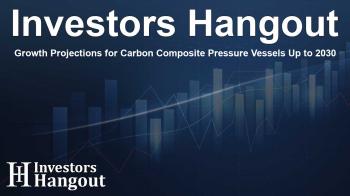Growth Projections for Carbon Composite Pressure Vessels Up to 2030

Insights into the Carbon Composite Pressure Vessels Market
The global carbon composite pressure vessels market is experiencing exponential growth. Valued at around US$1.7 billion in 2024, it is set to soar to US$5.2 billion by 2030. This growth, with a compound annual growth rate (CAGR) of 19.7% from 2025 to 2030, reflects a significant transition in various industries toward more efficient and sustainable solutions.
Market Overview
The report from Stratview Research gives a sweeping view of the carbon composite pressure vessels sector, outlining regional forecasts, market trends, segment analyses, and competitive dynamics. With strong emphasis on clean energy solutions, this shift is paving the way for the adoption of advanced materials and technologies.
Market Dynamics and Statistics
Here’s a breakdown of market statistics highlighting the key aspects:
- Market Size in 2024: US$1.7 billion
- Projected Size in 2030: US$5.2 billion
- CAGR: 19.7% through 2025-2030
- Cumulative Sales Opportunity (2025-2030): US$21.9 billion
- Leading Pressure Vessel Type: Type IV
- Primary Application: Transportation
- Predominant Gas Type: CNG/LNG
- Forecast Period: 2025-2030
- Trend Period: 2019-2023
- Base Year: 2024
- Segments Covered: 5
- Tables & Graphs: 100+
- Country Market Assessments: 20
Segment Analysis
The carbon composite pressure vessels market is segmented into various categories based on pressure vessel type, application, gas type, and production process:
Pressure Vessel Type
- Types III and IV dominate the market, with Type IV expected to lead in volume due to its lightweight properties, enhancing vehicle efficiency.
- Type IV vessels are widely used across different vehicles, making them crucial for fuel efficiency in passenger cars and commercial vehicles.
- Companies like Luxfer and Worthington are expanding their capabilities to meet demands for cleaner energy fuels.
Application Types
- The applications span transportation, gas storage, life support systems, and recreational uses.
- Transportation applications currently represent the bulk of demand, driven by hydrogen storage tanks for fuel cell vehicles (FCVs) and CNG tanks.
Gas Types
- CNG/LNG holds significant market share, but hydrogen is likely the game changer in the long run, propelled by investments in hydrogen infrastructure.
- Natural gas vehicles dominate the market, highlighting the demand for lightweight carbon composite vessels in heavy-duty applications.
Production Processes
- The market engages processes including towpreg and wet winding, with wet winding currently holding the largest market share.
- This method offers production efficiencies and quality, making it preferred among tank manufacturers.
Regional Insights
Asia-Pacific is emerging as a powerhouse for carbon composite pressure vessels, largely driven by its leading role in fuel cell electric vehicle (FCEV) production, especially in China and South Korea. Major FCEV companies like Toyota and Hyundai are spearheading the demand within this region, marking it as a key player in the global market landscape.
Drivers of Market Growth
- Shifts toward alternative fuel vehicles are catalyzing growth.
- Rising production rates of fuel cell electric vehicles underscore the trend.
- Investments in clean energy technologies are increasing.
- The market is witnessing a surge in the adoption of composite pressure vessels across various industrial applications.
Competitive Landscape
The competitive environment is marked by more than 30 global and regional players, with the top three companies controlling over half of the market share:
- Hexagon Composites ASA
- Luxfer Holdings PLC
- Worthington Industries, Inc.
- Others include Iljin Composites Co., Ltd., FORVIA, and Quantum Fuel Systems LLC.
Conclusion
The forecast for the carbon composite pressure vessels market is indicative of a robust transition towards cleaner energy solutions in transportation and beyond. With ongoing advancements in technology and growing emphasis on environmental sustainability, this market is set to evolve significantly in the coming years.
Frequently Asked Questions
What is the projected market size for carbon composite pressure vessels by 2030?
The market is expected to reach US$5.2 billion by 2030.
What has been the growth rate of the carbon composite pressure vessels market?
The market is forecasted to grow at a CAGR of 19.7% from 2025 to 2030.
Which region is leading in the carbon composite pressure vessels market?
Asia-Pacific is the leading region, driven by demand from major countries like China and South Korea.
What are the main applications for carbon composite pressure vessels?
The primary applications include transportation, gas storage, and industrial use.
Who are the key players in the carbon composite pressure vessels market?
Notable players include Hexagon Composites, Luxfer Holdings, and Worthington Industries.
About The Author
Contact Caleb Price privately here. Or send an email with ATTN: Caleb Price as the subject to contact@investorshangout.com.
About Investors Hangout
Investors Hangout is a leading online stock forum for financial discussion and learning, offering a wide range of free tools and resources. It draws in traders of all levels, who exchange market knowledge, investigate trading tactics, and keep an eye on industry developments in real time. Featuring financial articles, stock message boards, quotes, charts, company profiles, and live news updates. Through cooperative learning and a wealth of informational resources, it helps users from novices creating their first portfolios to experts honing their techniques. Join Investors Hangout today: https://investorshangout.com/
The content of this article is based on factual, publicly available information and does not represent legal, financial, or investment advice. Investors Hangout does not offer financial advice, and the author is not a licensed financial advisor. Consult a qualified advisor before making any financial or investment decisions based on this article. This article should not be considered advice to purchase, sell, or hold any securities or other investments. If any of the material provided here is inaccurate, please contact us for corrections.

